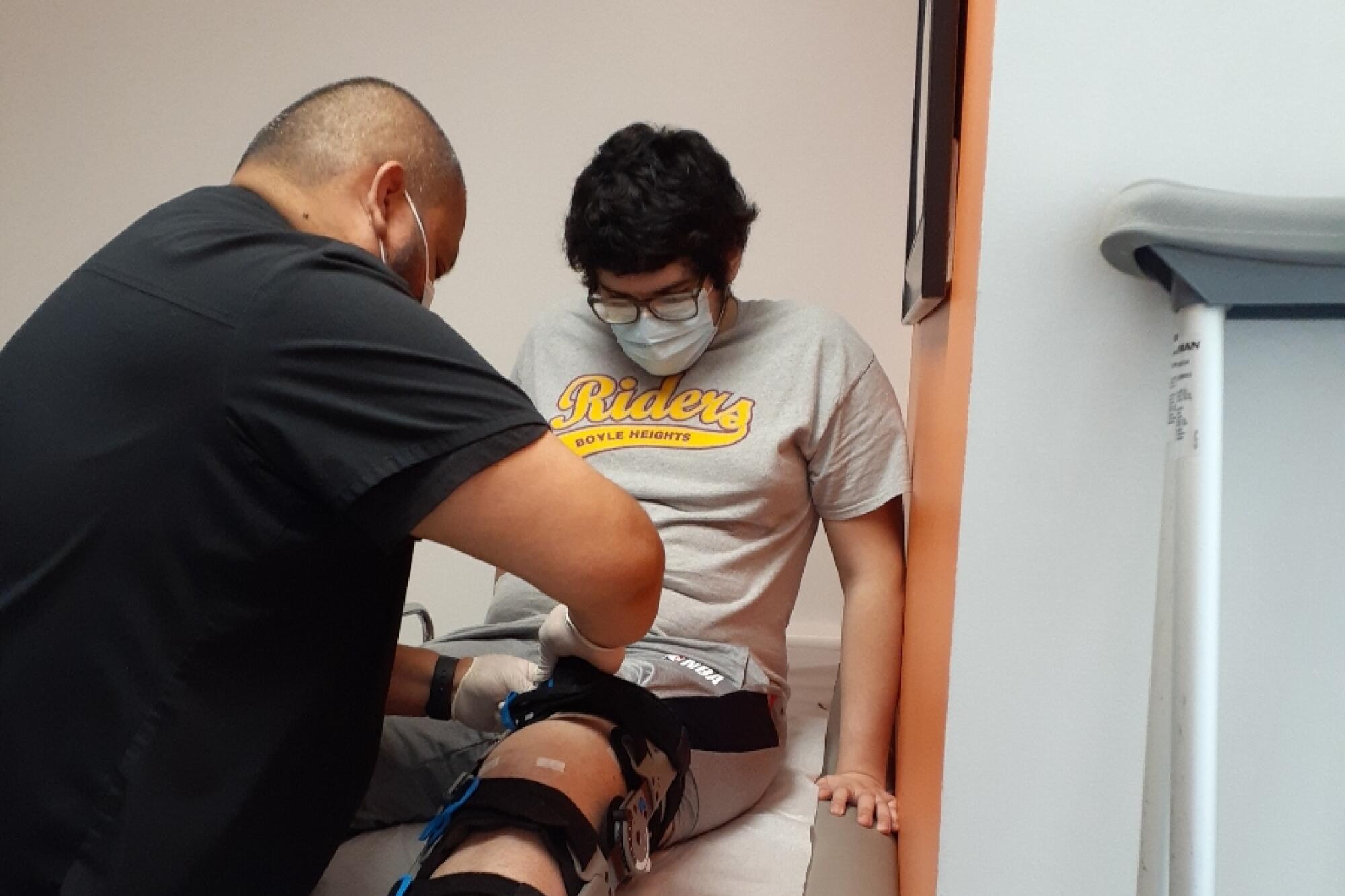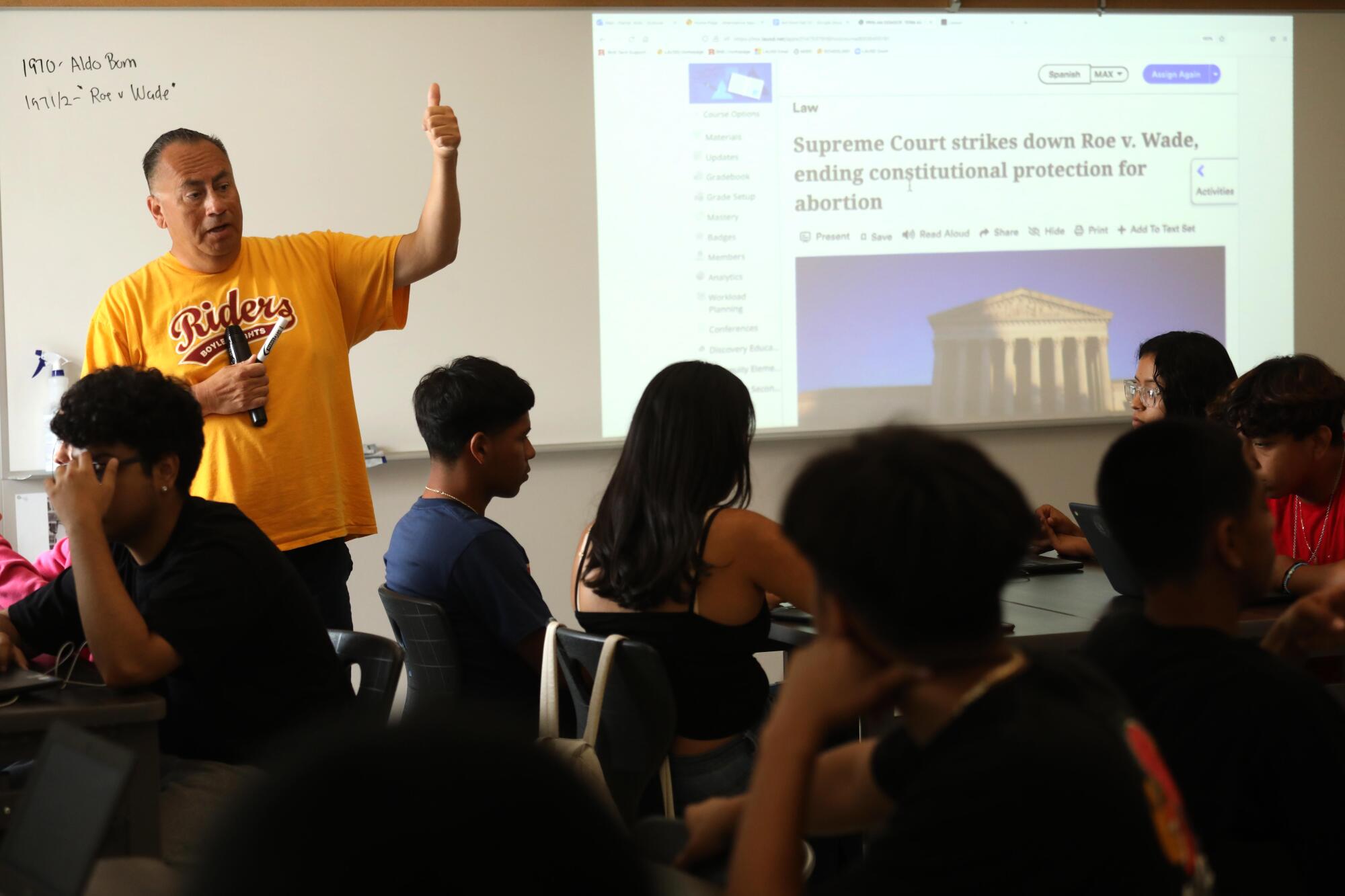
- Share via
Emmanuel Serafin sat and watched the rest of his teammates continue to practice, trying to figure out what could be done about a left knee that had suddenly folded backward.
With one misstep during a drill on a muddy Roosevelt High football field, all of Serafin’s momentum had come exploding down on his knee, wreaking havoc without any contact. His teammate had to help lug his 6-foot-2, 230-pound frame to the sideline, Serafin’s leggings revealing the indent of a misplaced bone.
There was nothing else to be done for the moment, because there was nobody else who could help. His coaches, as with any in the Los Angeles City Section, were required to take CPR and first-aid training.
But Roosevelt coach Aldo Parral is not a doctor or certified athletic trainer. He didn’t know what was wrong with Serafin’s leg. Nor would most coaches at an LAUSD campus; no immediate help to diagnose, to alleviate, to suggest anything close to the severity of damage Serafin’s knee sustained that day in November 2021.
That damage? Fractured tibia. Fractured femoral head. Internal bleeding. Torn anterior cruciate ligament. Torn posterior cruciate ligament. Torn meniscus.
So nobody had any better ideas, Serafin remembered, when he tried to stand up again after practice, felt his knee shift out of its socket, and took matters into his own hands.
Ignoring the fear, he pressed the back of his knee toward his shin and popped it back into place.
“We’re basic certified. We shouldn’t be dealing with this.”
— Al Rangel regarding coaches’ lack of athletic training skills
This is life in the City Section, where athletic trainers are a rare commodity. Part of the problem is that California is the only state that doesn’t mandate high schools provide an athletic trainer or have licensing, training requirements and regulations in place for them.
According to data presented by the California Athletic Trainers’ Assn. during a March summit at UCLA, only 4.8% of schools in the City Section employ a certified athletic trainer. That number jumps to around 50% in the Southern Section, which includes a wider range of private and charter schools.
L.A. Unified schools require emergency medical technicians to be present on the sidelines of football games, which helps in emergency situations such as the life-threatening head injury to Venice’s Nathan Santa Cruz last fall. Efforts are being made across the district, as Garfield football coach Lorenzo Hernandez said, to expand the presence of athletic trainers at secondary schools.
But in the present, Hernandez said, coaches without any medical background are “not just the first line” — they’re “the entire line.”
You understand the fear City Section coaches feel when you hear their voices shudder.
Everyone, it seems, has a story of trying to cope without an athletic trainer present — take South Gate basketball coach Al Rangel, who had to stop coaching in the middle of a playoff game last winter to try to figure out if his starting point guard had a concussion.
“We’re basic certified,” Rangel said. “We shouldn’t be dealing with this.”
While Serafin’s pop worked, his knee would shift out of place again if straightened, and he knew he needed a visit to an emergency room.
His entire household, besides himself, had COVID-19. So in lieu of an ambulance, his mother called his cousin, who lived in Eagle Rock, to take him to the emergency room.

When ER doctors examined his leg, the knee popped out of place again. After it was back in the socket and doctors had determined the severity of the damage, they gave him crutches and rolled him out on a wheelchair, telling him to keep his leg elevated to reduce inflammation until surgery.
For two weeks, Serafin couldn’t sleep. Shutting his eyes for five minutes didn’t help; neither did experimenting with increasingly large doses of codeine prescribed by the ER doctor. He spent weeks in his room, trying to make as tiny movements as possible, pain often his only company.
He and his mother, Maria Serafin, “cried for three straight weeks,” she remembered. A receptionist for a law firm, she’d lost her job as the world went remote in the midst of COVID-19, leaving her unable to pay for better insurance beyond Medi-Cal.
And on that plan, surgery was delayed so long — until May 2022, in part because of the pandemic — that eventually, Serafin remembered, he started walking on his knee before he got treatment.
“I just felt like I was being left alone — like all these walls were just falling in on me, and no one was helping out,” Serafin said. “You just feel lost, especially not knowing anything about it. There’s nothing really you can do.”
L.A. Unified has made efforts to increase athletic training services, starting with elevating Kirsten Farrell — formerly an athletic trainer at Venice High — to a district-level position as an “athletic training coordinator,” a role focused on finding more opportunities at school sites and funding partnerships.
“Los Angeles Unified understands the concerns raised about access to healthcare services for our student-athletes and we have taken the necessary steps to bridge this gap and enhance supports,” the district told The Times in a statement, along with information about Farrell’s position and organizational partnerships.
Progress has been slow because of budget constraints. LAUSD director of athletics Trent Cornelius said schools haven’t received extra money to cover a trainer’s salary. Fairfax principal Leonard Choi, who’s trying to create a full-time position at the school with a salary of $100,000 after an $80,000 grant from Cedars-Sinai community program Team HEAL, said he’s “scrimping and scrounging” to create the extra room in Fairfax’s budget.

The largest barrier to improved services, Cornelius said, is lack of awareness. California is the only state to not ensure some form of regulation or certification for athletic trainers.
Three separate bills to add licensing regulation for athletic trainers in the state passed through the California Assembly in 2010, 2014 and 2015, only to be vetoed by the governor. Gov. Jerry Brown felt the bill would put too many limits on the profession and make it illegal to use the title of athletic trainer without a college degree and “without sufficient evidence that they are really needed.”
Earlier this year, AB796, sponsored by Akilah Weber (D, La Mesa), passed the Assembly and is with a Senate committee for review. If passed, the bill would create a regulatory board for athletic trainers within the Department of Consumer Affairs that would govern licensing and oversight.
Specific legislation that certified the profession in California, Cornelius said, would make for an easier case to the LAUSD board to add trainers.
“If it’s not mandated, it’s viewed as something extra,” Cornelius said. “And when it’s viewed as kids’ safety, unfortunately, some people are waiting for mandates.”
What officials at secondary schools as a whole in Los Angeles still don’t understand, Farrell said, is the need for athletic trainers to combat the long-term effect of mistreated injuries.
A majority of players at City Section schools like Roosevelt or Jefferson, coaches said, are primarily covered by Medi-Cal, insurance that functions similar to an HMO with a plan that often limits coverage to doctors who contract with that organization.

Sarah Goble, an athletic trainer at Justin-Siena High in Napa, said one of the benefits she provides for students is “faster, easier care” in the event an athlete doesn’t have quality insurance. Thus, many advocates feel the lack of athletic trainers is a symptom of a larger conversation around the lack of healthcare access for lower-socioeconomic communities and communities of color.
“This is not Boobie Miles in ‘Friday Night Lights’ in the [1980s],” Farrell said. “A kid should be able to come back to their sport in six months.”
She said “the lack of access to the quality of healthcare that they deserve has lifelong impact on these kids.”
Anthony Jackson, the football coach at Los Angeles High — which has a minority enrollment of 98.5% and no athletic trainer — said he’s responsible for taping his players’ ankles or fingers, and he pays out of his own pocket to provide ice buckets in case of heatstroke. Coaches across the City said that the lack of care is another sign of a lack of support that disillusions prospective parents, which leads to enrollment somewhere else.
“We scrimmaged Diamond Bar [High] last summer, and they had like two [athletic] trainers on the field,” Parral said. “And we were like, ‘What the hell’s going on?’”
While he stood 6-2, Serafin sometimes felt small. Weak. He always looked forward to his senior year of football, when nobody would be bigger, nobody stronger, nobody else on top.
These days, he feels like his bones are grinding.
Every day brings pain, even after a successful surgery for a cadaver graft that will ward off arthritis. He’ll sometimes take a step and feel that slight hint of a spark in his knee. And the mental block goes up again, the fear that his knee never healed properly. The fear it’ll collapse again.
“It took a lot of my life … my senior year, away … I still wish there was help,” said Serafin, who now works at the Flower Market in downtown Los Angeles. “Someone to tell me where to go next, or what I should be doing.”
The surgeon told Serafin he’d be fine, his mother said.
He also told him the pain would never quite go away. And his knee would never be quite the same.
More to Read
Get our high school sports newsletter
Prep Rally is devoted to the SoCal high school sports experience, bringing you scores, stories and a behind-the-scenes look at what makes prep sports so popular.
You may occasionally receive promotional content from the Los Angeles Times.







